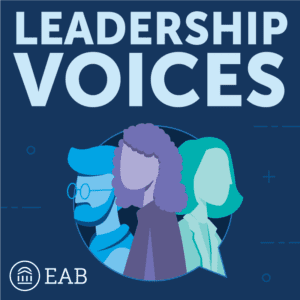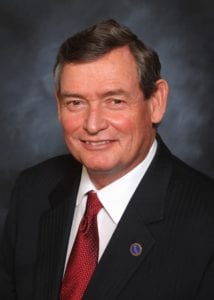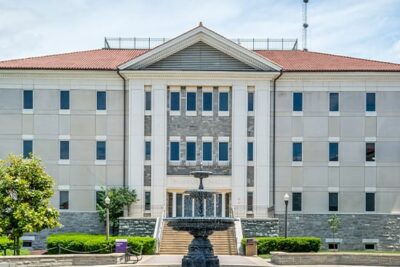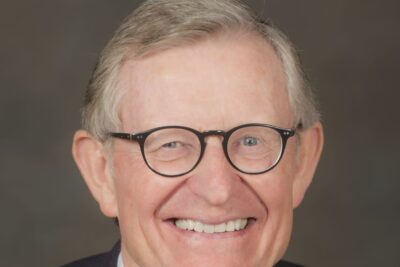
On May 12, Timothy P. White, the Chancellor of the California State University system, announced that the university’s 23 campuses and 480,000 students would proceed with primarily remote online education for fall. At the time, the CSUs were the largest and most visible institutions to decisively come down on the side of a virtual fall, when many campuses were hesitant to proceed.
In this conversation with Sally Amoruso, Chief Partner Officer of EAB, White explains what values have guided the decisions he and his system have made, how his campuses are addressing the pandemic’s outsized impact on the most vulnerable students, and what he remains hopeful about.
Sally Amoruso: You were the first major system to commit to remote-first instruction for the fall. What prompted you to make that decision? Were there dissenting voices? How did you come to consensus?

Tim White: Looking back, there were 3 things that came together in my decision-making. The first was the data and epidemiology. Early forecasting was pretty primitive in February and March, but as more data came in, they became more accurate. Sure enough, two weeks later, we made a massive pivot as ‘safer at home’ became the overriding public health directive. We recognized that it would be a difficult spring. But every indication also showed that what we’ve gone through so far would pale in comparison to what we’d experience in late October, November, with the confluence of influenza and attempts to repopulate schools and universities across the country.
Until there’s a vaccine that’s widely available, we’re not going to be able to cope.
The second was establishing values, or North Stars, around which every transactional decision could be made. My North Star was our commitment to our graduation initiative. No matter what, we’re going to continue to do that for as many students as possible.
The other North Star at the top of the list, of course, is health and safety. Not only students, but for faculty and staff, and the communities in which our 23 campuses are embedded with, an 800-mile swath of California.
“When you have values driving your decision and comfort with the possibility that you’re incorrect, it put us in a remarkable place.”
– Tim White, Chancellor of the California State University system
The final thing I considered was, what if we were wrong? I was totally at peace, as Chancellor, that if I had made the wrong call by announcing an online fall, I could live with that. That was comforting to me. We had to make tough decisions that have enormous impact on hundreds of thousands of peoples’ lives and livelihoods. But I couldn’t live the other way around.
When you have values driving your decision and comfort with the possibility that you’re incorrect, it put us in a remarkable place.
Amoruso: It’s a do no harm principle.
White: If we were wrong, we know how to pivot to in-person instruction in a heartbeat. We have centuries of experience in that approach in higher ed.
Early in the process, it became very clear to me, that with all the possible permutations and combinations, people in the university at every level were becoming unsettled. “What’s it going to be? Is it going to be this, or this, or this?” By deciding, we were able to focus on the virtual space.
A firm decision early on also gave our students and families clarity. It gave faculty the opportunity to do professional development over the summer, which thousands have done. We want you to go from being a remarkable biochemist to a remarkable biochemist in a virtual space, learning the modalities and the pedagogy to engage students. It’s not just a series of PowerPoints, but how you get that same vibrancy and engagement with students that you have in an in-person, face-to-face setting.
Some campuses expressed concern: they said that we are an applied university, we learn by doing, particularly at the polytechnics. But with some innovations by some faculty, a lot of those experiences can happen in the virtual space. It just required some deeper thinking to get there.
On the students and parents’ side, I got hundreds of negative letters with notes like “How dare you take away my daughter’s ability to have a college experience?”
Amoruso: How did you respond?
White: First of all, by acknowledging that for a new student, this is not what she’d been planning for, and for an ongoing student, this is not what he anticipated for a sophomore, junior, or senior year.
I acknowledge and respect that, but this is going to be an interruption of maybe of 20 or 25% of their total college experience. Everyone across the world is suffering, one way or another, to mitigate the pandemic and try to restart an economy. I acknowledge that this isn’t what they hoped for, but this is a fairly modest adaptation to try to mitigate the disease. We have shared responsibilities as members of a community and of a society to contribute to that. I appeal to what I believe.
“There’s a little bit of a silver lining here. So many companies have gone virtual… students are having to figure out how to succeed in a virtual space, which may very well be good job training for them when they graduate.”
– Tim White
Secondly, there’s a little bit of a silver lining here. So many companies have gone virtual. The big ones like Facebook and Twitter have said, “We’re not coming back to the office when this thing is over.” So students are having to figure out how to succeed in a virtual space, which may very well be good job training for them when they graduate. I think people will start realizing, “I am better prepared because I went through experience.”
The learning will happen. I think when people talk about college experience, they mean the socialization side. Yes, it has something to do with academic learning, but a lot to do with personal and social psychological development. And indeed, society is missing that and it’s a big issue.
But now, I have absolutely no regrets.
Amoruso: You’re probably feeling pretty prescient right now.
White: To be honest, I am very proud of us. Back in May, we made the really tough call against a lot of headwinds and then did the planning to execute it. Since we’ve announced, because of who we are, and the visibility of the decision, other universities began rethinking their priorities and made a change. During the last six weeks, many places have changed their plans. Many campuses that reopened but are now experiencing COVID-19 flare-ups are changing their plans. The sad thing is they are not prepared for vibrant education in the virtual space, and they could have been. And that’s going to hurt students.
“Many campuses that reopened but are now experiencing COVID-19 flare-ups are changing their plans. The sad thing is they are not prepared for vibrant education in the virtual space, and they could have been. And that’s going to hurt students.”
– Tim White
Amoruso: What students experienced this spring was not ideal online pedagogy. It was emergency online instruction. What are some of the elements of professional development you are providing to faculty to improve their teaching in the virtual space?
White: Our campuses set up institutes over the summer that provided four weeks of instruction, 20 hours a week, to work with professionals to translate their syllabus into a virtual experience for the fall. It wasn’t just a theoretical exercise; we practiced what would happen when there’s a rolling blackout. It was intended to be oriented to that person’s discipline and their specific courses, but also offered practical instruction on how to use the nuances of Zoom to move students in and out of small breakout discussions, etc.
The fact that the institutes were fully subscribed within days of being announced tells me that there’s a lot of faculty who are invested in being effective because they care so deeply about our students. They in turn will help their colleagues who may not have signed up or thought it was worthwhile.
But of equal importance, particularly for a university like ours, is the same level of professional training for academic support and academic advisors. We have to create that same engaged supportive environment, a place where a student can raise her hand and say help. The veteran center, the LGBTQ center, the cultural centers, they too need to be effective in the virtual space.
Amoruso: What about the classes that aren’t—or maybe can’t be—moving online?
White: On average, across the system, a little less than 7% of our courses will be face-to-face. The face-to-face courses all require something special. We wanted to make sure it wasn’t just for STEM. We’ve been thinking about creative artists who need to paint pictures in huge buildings, as well as aeronautical engineers and architecture students. Animal husbandry, you know, is pretty hard to do virtually.
<7%
Amoruso: [Laughs] Yes, it is. In my conversations with presidents, athletics have been a top concern. What call did you make there?
White: We’re in 5 different athletic conferences, and all five postponed or canceled fall sports. Now there is a chance for athletes in every Division to work on their strength and conditioning under COVID conditions. But it’s also a chance for them to focus on their studies, maybe take an extra class, and get ahead academically. It was very frustrating for the student-athletes, but it’s also very frustrating for the students in theatre, orchestra, and band.
Amoruso: I also wanted to talk about racial equity. You’ve always been a champion of underrepresented minorities and have embraced anti-racism on your campuses. In fact, you have an ethnic studies requirement that was just signed into law. How have you been managing those issues during COVID?
White: Communities don’t hide from tough issues. They actually come together. The issue of equity is really the issue of justice itself: health, economic, policing, environmental. The part that we can do the most about is education equity: continuing to welcome our students and get them to earn their degree, which then leads them to a career that helps them achieve economic equity. No matter what economy we’re in, you’re better off if you have a baccalaureate degree than if you don’t. Even today, the unemployment rate for bachelor’s degree holders is half that of those without. By hook or by crook, no matter how long it takes, earn that degree. We’ll do our part to make it available.
Amoruso: I’ve been stunned that the retention rates have been very strong for Pell-eligible students across the spring. You all are super users of EAB’s Student Success Management System Navigate. I want to hear how you’re approaching the digital divide that has disproportionately affected vulnerable student populations.
White: We’ve distributed thousands of loaner laptops and personal hotspots. Our campuses have created WiFi hotspots in our parking lots. It might not be comfortable in the backseat of your car, but if it’s safe and you have access to bandwidth, it’s better than not having access. Our partnership with Logitech gave us thousands of headsets to give to students.
The governor has a council on postsecondary education, of which I am a member. We’ve advocated for increasing bandwidth for all. Will that solve all problems by October 1? No. But will a statewide commitment go further in getting rid of the digital divide? Yes. That’s going to be a long-term benefit for marginalized, low-income and rural communities.
Amoruso: I understand you also made aid available for Dreamers, which is another cause that is near and dear to your heart.
White: Yes, and to international students. COVID wasn’t selective just for domestic students who are US citizens. COVID also introduced profound difficulties for international students, Dreamers, and DACA recipients.
Amoruso: One final question. You talked about one silver lining: that your students will learn to operate in a virtual world through this. Are there any other silver linings that higher ed leaders should be leaning into?
“Hollywood figured out a long time ago that the virtual world can be very real. I believe over the next handful of years, the things that people said could only happen in-person—like the basic learning in chemistry and life science laboratories—will go away.”
– Tim White
White: Hollywood figured out a long time ago that the virtual world can be very real. I believe over the next handful of years, the things that people said could only happen in-person—like the basic learning in chemistry and life science laboratories—will go away.
I dream of a day when technology-enhanced, high-touch learning environments will bring down unnecessary costs. I also recognize that the interaction among students is really important. The development of relationships, professional and personal, is very much a part of the university experience.
I’m perennially optimistic. And I’m optimistic about the courage to keep the good, and also the courage to recognize the things that didn’t work out—that they were a bridge to get us through tough times and we can discard in the future.
Dr. Timothy P. White is chancellor of the California State University, one of the largest and most diverse systems of higher education in the United States. As chancellor, White leads a university of 23 campuses and a global community of 481,000 students, 53,000 faculty and staff and more than 3.8 million alumni.
He leads the CSU as it implements Graduation Initiative 2025, an ambitious systemwide plan to increase graduation rates, decrease time to degree and eliminate achievement gaps for all students. White deeply believes in and is a product of California’s Master Plan for Higher Education. Like many CSU students and alumni, White is an immigrant from Argentina and was the first in his family to attend college and earn a degree.
Leadership Voices is a series spotlighting vision and courage through crisis. Nominate college presidents who have acted with extraordinary leadership at [email protected]
How college presidents lead through crisis
Leading in times of crisis: How a wildfire prepared this president for COVID-19
President Ann McElaney-Johnson of Mount Saint Mary's University shares how she led her campus through a wildfire—and how the experience informed her response to COVID-19.
How a public health expert responded to COVID-19 on campus
"Our people are afraid, whether it's our board members, faculty, staff, students, or members of our community. But I am hopeful and confident that information can help us overcome fear," says Dr. Melinda Treadwell, president of Keene State College.
How Colleges Can Plan for and Adapt to Campus Crises
Learn how college administrators can use this crisis to strengthen leadership skills—and how schools can build greater organizational resiliency to better prepare for, respond, and adapt to future disruptions.
How one university overcame two natural disasters
In times of uncertainty, you need to lead with your heart as well as your head, says Dr. David Hall, the president of the University of the Virgin Islands.


